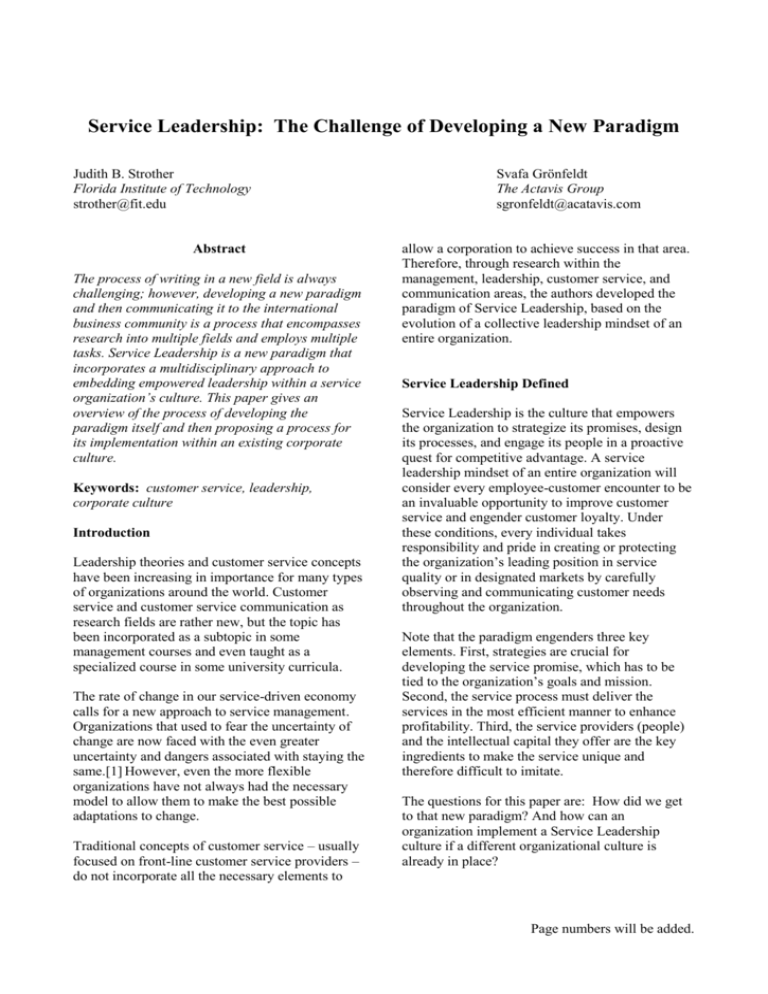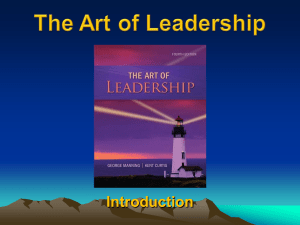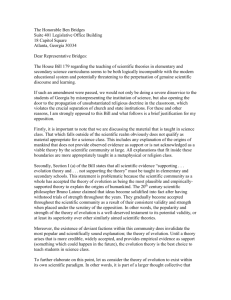Service Leadership: The Challenge of Developing a New Paradigm
advertisement

Service Leadership: The Challenge of Developing a New Paradigm Judith B. Strother Florida Institute of Technology strother@fit.edu Abstract The process of writing in a new field is always challenging; however, developing a new paradigm and then communicating it to the international business community is a process that encompasses research into multiple fields and employs multiple tasks. Service Leadership is a new paradigm that incorporates a multidisciplinary approach to embedding empowered leadership within a service organization’s culture. This paper gives an overview of the process of developing the paradigm itself and then proposing a process for its implementation within an existing corporate culture. Keywords: customer service, leadership, corporate culture Introduction Leadership theories and customer service concepts have been increasing in importance for many types of organizations around the world. Customer service and customer service communication as research fields are rather new, but the topic has been incorporated as a subtopic in some management courses and even taught as a specialized course in some university curricula. The rate of change in our service-driven economy calls for a new approach to service management. Organizations that used to fear the uncertainty of change are now faced with the even greater uncertainty and dangers associated with staying the same.[1] However, even the more flexible organizations have not always had the necessary model to allow them to make the best possible adaptations to change. Traditional concepts of customer service – usually focused on front-line customer service providers – do not incorporate all the necessary elements to Svafa Grönfeldt The Actavis Group sgronfeldt@acatavis.com allow a corporation to achieve success in that area. Therefore, through research within the management, leadership, customer service, and communication areas, the authors developed the paradigm of Service Leadership, based on the evolution of a collective leadership mindset of an entire organization. Service Leadership Defined Service Leadership is the culture that empowers the organization to strategize its promises, design its processes, and engage its people in a proactive quest for competitive advantage. A service leadership mindset of an entire organization will consider every employee-customer encounter to be an invaluable opportunity to improve customer service and engender customer loyalty. Under these conditions, every individual takes responsibility and pride in creating or protecting the organization’s leading position in service quality or in designated markets by carefully observing and communicating customer needs throughout the organization. Note that the paradigm engenders three key elements. First, strategies are crucial for developing the service promise, which has to be tied to the organization’s goals and mission. Second, the service process must deliver the services in the most efficient manner to enhance profitability. Third, the service providers (people) and the intellectual capital they offer are the key ingredients to make the service unique and therefore difficult to imitate. The questions for this paper are: How did we get to that new paradigm? And how can an organization implement a Service Leadership culture if a different organizational culture is already in place? Page numbers will be added. The Research Process The concept of service leadership is based on a multi-disciplinary approach drawing on theories of leadership, corporate culture, customer service, and methods of strategic management, service management, and human resource management, among others. Service is composed of intentions, interactions, and impacts. In other words, a service organization intends to provide a certain set of services based on the organization’s corporate and service strategies. These strategies are carefully formulated to optimize the organization’s operational efficiency and to fulfill expected customer needs. The intended services or the service promise is then delivered through interactions with the customers. The interactions are regulated by service processes which can be automated, technologically assisted, or totally dependent on human contact. The impact of that interaction depends on how well the customers’ expectations are met, which in turn affects their level of satisfaction. The impact is delivered through people and processes, which determines customers’ loyalty and thus ultimately the organization’s profitability. To accomplish this service leadership revolution, pervasive changes must be implemented for the service promise, the service design process, and the utilization of human resources embedded in the people of the organization. The traditional idea of a corporate culture must be expanded. Therefore, all of these areas had to be carefully researched, which led to the following assumptions for the concept of Service Leadership: ASSUMPTION I: Organizations can achieve competitive advantage in service through a collective leadership mindset based on strategic application of processes and people to design and deliver the service promise. ASSUMPTION II: The process assures competitive advantage through speed and accuracy and adaptability of the service delivery and enhances organizational efficiency by maximizing both internal and external resources. ASSUMPTION III: The people assure competitive advantage through proactive adaptability to change by employing innovation, flexibility, and motivation to move the organization forward. Page numbers will be added. The theoretical framework suggests that the leadership mindset of organizational members is powerful and can be a driving force for sustainable competitive advantage. The following sections present a quick overview of key research areas and how the findings helped frame the new service leadership paradigm. Leadership Theories The challenges are great for today’s service organizations, but the opportunities for those who master the science of leadership in the service sector are also tremendous. The act of leadership can be integrated into both marketing and operational strategies of any service organization. In fact, in today’s service-driven economy, you cannot expect to achieve one without the other. The common denominator is the focus on assuming a leadership role – either as a company in the marketplace or as an individual within the organization, regardless of formal authority or power. Thus, the first research area is leadership theory. Theories of leadership have transitioned through a number of different trends over their very lengthy history, an overview of which is given in Grönfeldt and Strother’s Service Leadership: A Quest for Competitive Advantage.[2] Recent developments have moved away from the concept of a single powerful individual, labeled a leader, to a broader concept of leadership aimed at achieving a group goal, not just because of the efforts of one skilled person but because of the contributions of group members. [3] Manz and Sim’s idea of “Super Leadership” purports that the most appropriate leader is one who can lead others to lead themselves.[4] Today, leadership is viewed more as a process and is closely associated with corporate culture. In these theories, a particular group or an organization may include a leader, but when everyone is involved and expected to play an active role in moving the organization forward through leadership efforts, no one needs to be motivated and dominated by that leader. In this view, many individuals can exert small degrees of leadership, regardless of their personal power or their position within the organization. Traditional leadership theory has focused on various traits and behaviors of individual leaders and the circumstances in which they find themselves. This often causes us to overlook the real leadership potential all around us. Organizations can no longer rely on single great individuals or leaders to adapt to the ever-changing marketplace and the diversity of consumers’ needs. House and Aditya [5] argue that there is no evidence that supports claims of stable and longterm effects of leaders on followers’ self-esteem, motives, desires, preferences, or values. The leaders can, without a doubt, cause changes in followers’ psychological states, but these states often do not continue after the separation of the leader and followers. Further, there is little evidence that charismatic, transformational, or visionary leadership does indeed transform individuals, groups, large divisions of organizations, or total organizations, despite claims that they do so. Scholars have now begun to recognize that we know too much about leaders, but too little about leadership and its collective power. Linsky and Heifetz [6] suggest that successful individuals, whom we so often tend to label as leaders, cannot automatically attribute their success to leadership. They claim those individuals have mastered the art of monitoring and fulfilling the needs of those around them, causing them to focus all their efforts on performing anticipated or expected acts. Thus, the organization keeps this “leader” safely tucked away within his or her scope of authority. This, according to these Harvard professors, is not leadership. To them, the act of leadership demands courage to go beyond the safe zone of anticipated acts. Not only do leaders have to dare to be innovative, leadership itself must be distributed throughout the organization and its culture. Therefore, a collective effort is needed where every individual believes his or her interest is best served by protecting and preserving the organization’s interests and takes the initiative within the framework of the organization’s goals to do so. Distribution of leadership allows for the possibility that all members of an organization can and may be leaders in some sense and that each employee considers leadership an integral part of the job. In that respect, managers may be leaders but not necessarily by virtue of just holding management positions. In fact, leadership has become a question of influence – not just authority. Theories of Organizational Culture Organizational or corporate culture is “the glue that holds an organization together, or the rock on which it stands.”[7] It can be regarded as “a set of assumptions, values and beliefs which determine the nature of truth” or “the way an organization exerts control over its members and how behavior is regulated.”[8] The concept is difficult to describe and even harder to understand. The big question is whether the culture helps or hinders the organization’s ability to execute its strategic objectives. An organization cannot ignore its culture and just hope it develops well. An organization must be proactive about using its culture to fully execute its strategy and inspire creativity and innovation. The concept of service leadership builds on ideas of strategy as perspective or culture and theories of leadership as a collective mindset. Henry Mintzberg,[9] one of the leading contemporary scholars in strategic management, has identified various approaches to strategy formulation and application. One of those strategies is the cultivation of a strong organizational culture. The culture centers around strong organizational values and norms, reinforcing certain sets of behaviors needed to give the organization a competitive edge. No organization has one pure culture throughout the entire organization but all successful organizations are believed to have a core culture. That core culture is fundamental to the way an organization functions. Without it, the focus of resources and organizational operations is lost and energy is wasted as people, systems, and processes work out of sync with one another. For the organization to succeed, the core culture must be aligned with the organization’s strategy and its core leadership practices.[3] For the last decade, strong organizational cultures have been believed to be critical to bottom-line performance in large organizations. In fact, commitment-based organizations packed with people who fit the organization’s values perfectly have repeatedly out-performed other organizations. “The major distinguishing feature in these companies, their most important competitive advantage, the most powerful factor they all highlight as a key ingredient in their success, is Page numbers will be added. their organizational culture.”[10] Because organizational culture is more powerful than anything else, it has been suggested that no management idea will work in practice if it does not fit the organizational culture, which is “so powerful in fact, that its impact supersedes all other factors when it comes to organizational performance.”[11] Empowerment Theories The debate over how much individual power individuals should have in an organization has been carried out at least since the beginning of the Industrial Revolution. Since 1990, there have been countless empirical and applied research studies dealing with employee empowerment. In fact, the 1990s were labeled the empowerment era.[12] What does the term empowerment actually mean? How has it been applied and can it be applied successfully in a service context? In the new organizational structure where employee participation is expected and indeed needed, the term empowerment is typically used to describe managements’ efforts to involve employees in decision making. No consensus has been reached regarding the concept of empowerment or how far organizations should take it. Some definitions of empowerment suggest complete and almost uncontrolled power in the hands of employees. Although many managers recognize the importance of fast decision making and flexibility, this is almost a “license to act irresponsibly” and represents one end of the continuum. At the other end is the limited or controlled empowerment, which involves structured teamwork through careful experimental design, structured meetings, and strict goal-setting and measurement. The new paradigm takes the management practice of empowerment a step further in an attempt to overcome the disadvantages associated with power transfer and to fully capitalize on investments in higher labor and training costs. In service organizations aiming for service excellence, employees must not have just the authority to point out issues or watch and wait for things to happen. They must always desire service excellence and regard it as their responsibility to be proactive in order to protect and preserve their organization and to collectively shape their future working environment and organizational success. Page numbers will be added. While most managers are fully aware of the importance of cultural management, they may be unable to develop the clarity, consistency, and comprehensiveness that are needed to have the desired effect on employees. In fact, organizational cultures have turned out to be more than most managers bargained for, both as an enabler of competitive advantage as well as a stumbling block for organizational efforts to improve processes and performance. Management Theory Adopting an atmosphere of empowerment calls for a change in employee and managerial roles. It also calls for a reversal in the traditional relationship between service provider and customer. Instead of the employee just doing what the manager dictates, he or she must do what the customer wants and needs. As Lindsky points out, “in a firm with a leadership culture, leadership means exercising discretion, taking risks and, again in this context, first meeting the customers’ needs in ways that might well be beyond SOPs [Standard Operation Procedures], job descriptions, and formal authorization, asking for forgiveness later rather than approval beforehand.”[13] The manager’s role becomes the creation of certain conditions for active employee participation and initiative. Quinn and Spreitzer,[14] suggest that managers must continuously (1) work to clarify the sense of strategic direction for their people to set a clear strategic vision; (2) strive for participation and involvement to foster openness and teamwork; (3) work to clarify expectations regarding the goals, tasks, and lines of authority to provide a sense of discipline and control; and (4) work to resolve the conflicts among their people to give a sense of support and security. Furthermore, research has shown that employees initiate action and participate more actively when they are intrinsically motivated or have internal justifications for their actions. Managers need to help create a working environment where employees’ behaviors are governed from within, but guided by a clear well-defined corporate framework. If managers at all levels are now faced with changing roles, then human resources (HR) managers are no exception. Like all other managers, HR professionals are usually not comfortable with having to transform their current personnel practices or to question the assumptions and principles on which they are based.[15] Baron [8] has suggested that human resource personnel can be described as the “guardians of culture.” Human resource managers who want to create a competitive advantage are faced with the following issues:[16] A building challenge – recruitment and selection A linking task – knowledge management through social networks A bonding process – within the culture, through loyalty, commitment, and a sense of belonging While some of the elements have always been under its purview, the role of HR managers must shift to support the new service organization. Their perspective on employees must change from viewing people as a part of production or as just another resource to building human capital as a core source of competitive advantage. Initiating Change This new service leadership model requires the changes discussed above throughout the entire organizational culture. Just how is this accomplished in an organization that does not have the required elements? Bringing about constructive organizational change is one of the most difficult challenges today’s managers face. Organizations must look to the future for answers, not to the past. The thinking must be shifted from action and reaction to anticipatory action – becoming very proactive. Effective communication is a critical element of successfully implementing change in an organization. Organizations can move effectively toward their goals if communication is accurate, thorough, and timely. However, if communication is hampered, the entire organization suffers. The challenge for managers in organizations facing rapid changes and harsh competition is to use communication to motivate innovation by creating a supportive climate, which will in turn enhance the organizations’ ability to adapt to changes. An innovative organization differs from a less innovative one in the amount of financial and emotional support it devotes to innovation efforts.[17] A supportive climate encourages worker participation, the free and open exchange of information, and the constructive conflict resolution that is necessary to foster innovation. Planning a change strategy for a new communication climate takes both time and effort. No simple recipe can ensure success: there are, however, some basic principles that have proven successful in a number of organizations.[18] If the communication climate change is to be carried out successfully, the management must, through the organizational culture and climate, implement a plan of action regarding how change is to be carried out. The management must Plan the phases of the change. Take steps to reduce uncertainty associated with the change. Tailor change strategies to individual managers’ styles. Take appropriate action to organizational members’ reaction to each change phase. Emphasize innovation. Enhance the effectiveness of managementemployee communication. Change the employee perception of the management. Enhance management’s interpersonal skills and communication. The change must consist of researching to enhance decision making, planning what is to be accomplished, and strategizing to minimize uncertainty associated with the change. The main risk inherent in changing the corporate climate is that the organization may operate less effectively while the new climate is being created, and as managers modify their practices, procedures, and behaviors to foster it. However, the more consistent management messages are about the new priorities, and the better these priorities are backed up by resources, training, employee recruitment, orientation, and effective reward systems, the more successful the organization will be in facing its challenges and effective the desired change.[19] Page numbers will be added. Evaluating Change Conclusion Any organization should employ comprehensive measurement and evaluation processes to determine whether the changes being implemented and the training being conducted are achieving the desired result. Since training takes financial resources away from other needs of the organization, the evaluation process helps management determine whether funds are being well spent and can provide a justification for allocating future funds. In addition, measures make the result of the initiative more tangible, thereby enhancing the commitment of managers to use human-resource-development tools and techniques. The development of the new paradigm of Service Leadership has been a journey of discovery through mountains of literature in a number of different fields. It has required synthesizing information and creatively looking at new ways of meshing and implementing key theories. However, it has been rewarding, both in initial reactions to the new concept, in anticipated discussions resulting from the publication of the paradigm, [2] and in the firm belief that the implementation of the concept, while extremely challenging, will be well worth it for the organizations involved. All performance-improvement initiatives must be aligned with organizational strategies and values. To accomplish this alignment, a number of objectives have to be put in place before a new training program can be launched. Hodge [20] has identified the following three objectives important for this task. Business objectives specify what the participant will accomplish as a consequence of the application of skill and knowledge in measurable business terms. Performance objectives provide precise, measurable statements of the behaviors that participant will be able to demonstrate on the job. Learning objectives describe what participants will be able to do at the end of their training or intervention program, matching the performance objectives as closely as possible. Philips and Stone [21] have presented a framework for evaluating training and educational programs, human resource programs, organizational development or change initiatives, and technology initiatives. The framework draws on the work of Donald Kirkpatrick, a pioneer in the field.[22] Philips and Stone use Kirkpatrick’s four levels of evaluation and add the fifth. The levels measure (1) the participants’ immediate reactions to the training, (2) the amount of learning that has taken place as a result of the training, (3) the extent to which the new skills or knowledge are applied on the job after the training, (4) the business impact of the initiative and finally (5) the potential return on investment (ROI) in monetary terms. Page numbers will be added. There is no doubt that, when an entire organization considers each encounter between an employee and a customer to be a rich opportunity to improve customer service and build customer loyalty, a leadership mindset is in place. In this situation, every employee takes responsibility and pride in helping the organization reach a high level of service quality. They do this by carefully observing and communicating customer needs through organizational channels. Service Leadership brings a new view of roles and relationships and empowers the entire organization to streamline its strategies and processes accurately and in a timely manner. Effective communication is critical at all stages of the process – from facilitating new ideas to providing employees with needed customer or product information, to building an organizational consensus. This new model gives the organization the ability to be proactive in continuous service adaptation, which, in turn, gives it a solid competitive advantage in the marketplace. References [1] K. S. Cameron & R. E. Quinn. Diagnosing and Changing Organizational Culture: Based on the Competing Values Framework. Reading, MA: Addison-Wesley, 1999. [2] Svafa Grönfeldt and Judith Strother. Service Leadership: A Quest for Competitive Advantage. Thousand Oaks: Sage Publications, 2005. [3] See e.g., M. Horner. “Leadership theory: past, present and future.” Team Performance Management. Bradford. vol. 3, no. 4, 1997; W. H. Drath & C. J. Palus. Making Common Sense: Leadership as Meaning-Making in a Community of Practice. Greensboro, NC: Center for Creative Leadership, 1994. [4] C. C. Manz & H. P. Sims, Jr. “Super Leadership: Beyond the myth of heroic leadership,” Organizational Dynamics, vol. 19, 1991. [5] R. J.House & R. N. Aditya. “The Social Scientific Study of Leadership: Quo Vadis? Journal of Management, vol. 23, no. 2, pp. 410, 1997. should consider,” Organizational Dynamics, vol. 26, no. 2, 1997. [15] A. J. Godbout. “Managing core competencies: The impact of knowledge management on human resource practice in leading-edge organizations.” Knowledge and Process Management. vol. 7, no. 2, pp. 237-247, 2000. [16] C. A. Bartlett & S. Ghoshal. “Building Competitive Advantage Through People,” MIT Sloan Management Review, pp. 34-41, 2002. [6] R. A. Heifetz and Marty Linsky, Leadership on the Line. Cambridge, MA: Harvard Business School Press, 2002. [17] B. Schneider, S. K. Gunnarson, & K. NilesJolly. “Creating the climate and culture of success.” Organizational Dynamics, vol. 23, no. 1, pp. 17-28, 1994. [7] J. A. Chatman & S. E. Cha. “Leading by leveraging culture,” California Management Review, vol. 45, no. 4, pp. 20-32, 2003. [18] Phillip G. Clampitt. Communicating for Managerial Effectiveness 2nd edition. Thousand Oaks: Sage Publications, 2002 [8] A. Baron. “Winning ways with culture,” Personnel Management, vol. 36, no. 10, pp. 64-68, 1994. [19] P. Shockely-Zalabak. Understanding Organizational Communication. NY: Longman, 1994. See also B. Scanlan & B. Keys. Management and Organizational Behavior. Malabar, FL: Krieger Publishing, 1987; [15, 16]. [9] H. Mintzberg. & B. Quinn. The Strategy Process: Concepts, Context, Cases. NJ: PrenticeHall, Inc., 1996. [10] K. S.Cameron & R. E.Quinn, R.E. (1999). Diagnosing and Changing Organizational Culture: Based on the Competing Values Framework, Reading, MA: Addison-Wesley. p. 4, 1999. [11] S. P. Kotter & J. L. Heskett, J.L. Corporate Culture and Performance. NY: The Free Press, 1992 in W. E. Schneider. “Why good management ideas fail: The neglected power of organizational culture,” Strategy and Leadership, vol. 28, no. 1, pp. 24-29, 2000. [12] S. H. Applebaum, D. Hebert, & S. Leoux, S. “Empowerment: power, culture and leadership – a strategy or fad for the millennium?” Journal of Workplace Learning, vol. 11, no. 7, pp. 234, 1999. [13] Marty Linsky and R. A. Heifetz. “Preface,” to Svafa Grönfeldt and Judith Strother. Service Leadership: A Quest for Competitive Advantage. Thousand Oaks: Sage Publications, 2005. [14] R. E. Quinn and Spreitzer. “The road to empowerment: seven questions every leader [20] T. K. Hodge. Linking Learning and Performance: A Practical Guide to Measuring Learning and On-the-Job Application. Boston: Butterworth-Heinemann, 2002. [21] J. Phillips & R. D. Stone. How to Measure Training Results: A Practical Guide to Tracking the Six Key Indicators. New York: Mc-Graw Hill, 2002. [22] Donald Kirkpatrick. “Techniques for evaluating training programs,” Training and Development Journal. vol. 33, no. 6, pp. 78-92, 1979. About the Authors Judith Strother, an Associate Member of IEEE, is Professor of Applied Linguistics and Chair of the graduate program in Technical and Professional Communication at Florida Institute of Technology. Svafa Grönfeldt is Chief Executive of Strategy and Organizational Development for Actavis Group. She is also Associate Professor of Management Studies at The University of Iceland. Page numbers will be added. Page numbers will be added.









